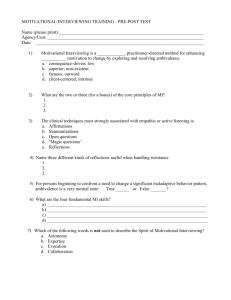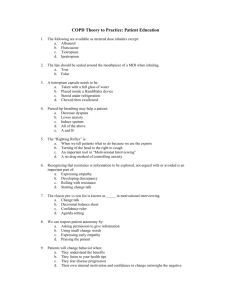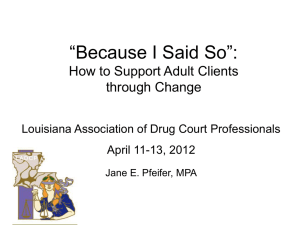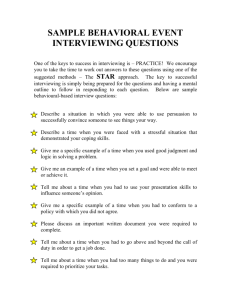PowerPoint
advertisement
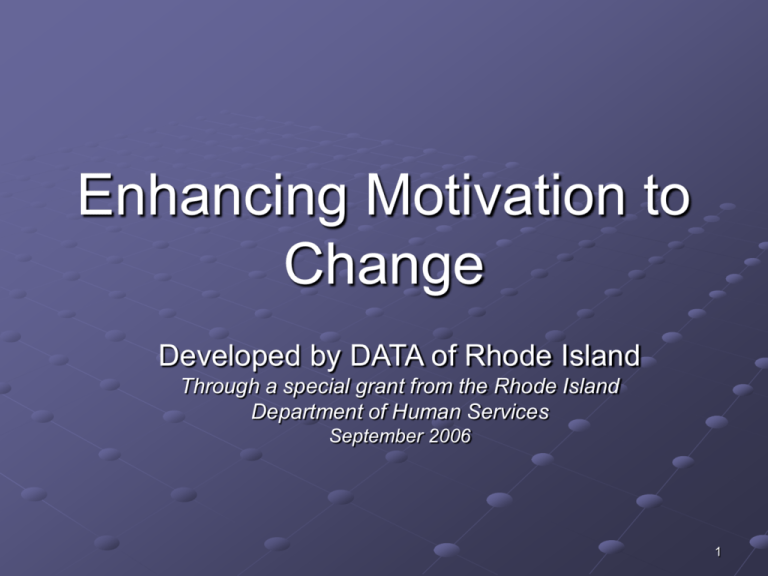
Enhancing Motivation to Change Developed by DATA of Rhode Island Through a special grant from the Rhode Island Department of Human Services September 2006 1 Motivational Interviewing has been successfully used to assist people with a variety of problems: •Alcohol Abuse •Drug Abuse •Dual Diagnosis •Diabetes •Gambling •Mental Health •Smoking •Cardiovascular Health •Eating Disorders •Health Promotion •HIV Risk 2 The Goal of Today’s Training is: For trainees to learn about: stages of readiness to change motivational interviewing (MI) how to utilize MI techniques to more effectively assist people to make life changes in a variety of areas 3 Group Discussion Questions: Why don’t People Change? 1. 2. 3. 4. 5. 6. ______________________________ ______________________________ ______________________________ ______________________________ ______________________________ ______________________________ 4 Group Discussion Questions: Why do People Change? 1. 2. 3. 4. 5. 6. ______________________________ ______________________________ ______________________________ ______________________________ ______________________________ ______________________________ 5 Motivational Interviewing: Readiness to Change 4 possible change options: 1. Not ready 2. Unsure 3. Ready 4. Trying 6 The Goal of MI: To Assist People to Become Ready, Willing, and Able Willing: The Importance of Change Able: Confidence for Change Ready: A Matter of Priorities 7 What Motivates Change? Self questioning Values Needs Readiness Anxieties Insight Desire Discovery 8 Motivational Interviewing A Definition – Bill Miller, PhD Motivational interviewing is a person-centered directive method of communication for enhancing intrinsic motivation to change by exploring and resolving ambivalence 9 Four Basic MI Skills: OARS Ask OPEN questions not short-answer yes/no rhetorical questions AFFIRM the person comment positively on strengths, effort, intention, REFLECT what the person says "active listening“ SUMMARIZE draw together the person's own perspectives on change 10 Open/Closed Questions Formulate Open and Closed Q’s regarding: About changing (i.e., smoking, diet, exercise, etc.) About what may happen in the future (without change, with change) About the negative consequences already experienced About the differences in _________ between now & then Confidence About changing (i.e., smoking, diet, exercise, etc.) Importance About what may happen in the future (without change, with change) About coping with temptation About maintaining motivation About what could be of help to you 11 Stages of Change Model Maintenance Precontemplation Relapse Action Contemplation Preparation Determination 12 Stages of Change Pre-contemplation Contemplation Preparation/Determination Action Maintenance Relapse 13 PRE-CONTEMPLATION No intention of “Who, me?” changing target No consideration to change Lack of motivation to change Low self-efficacy Lack of information Contentment with status quo behavior No action toward change Engages in targeted behavior freely Does not connect life difficulties to the behavior 14 Precontemplation Client 1 Person is not yet considering the possibility of change. 2 Person does not actively pursue treatment. Helper a Helper needs to provide information and personalized feedback in order to increase client’s awareness. b Giving advice is counterproductive 15 A Typical Day A. Explain the purpose & define a time-frame Can we spend the next few minutes talking about ______so that I can better understand how it fits into your everyday life? B. Locate the day/session to be described Think of a typical recent day (time) which would give me a good picture of how you use ___. Can you think of one? C. Ask for a detailed description I’d like you to take me through this day, a step at a time and tell me how _____ fits into the day. You woke up at _____? D. Follow the person’s statements with open-ended questions and short summaries 16 Core Value Discrepancy Which of the following values, traits, or characteristics are important to you? good parent good spouse/partner god community member strong on top of things competent spiritual respected @ home good Christian, Jew, Moslem, etc. attractive disciplined responsible in control respected by others athletic organized energetic compassionate dependable honest open-minded 17 Core Value Discrepancy How, if at all, is your current behavior related to these? How, if at all, does your current behavior affect your ability to achieve these goals or live out these values? I’m curious….. Do you see a connection between your ____ behavior and any of these values/goals? I’m curious….. Do you see a connection between your health and any of these values/goals? Do you see any connection between your ___ behavior and your health? 18 Readiness Ruler “How important is it for you to change?” How confident are you that you could change if you decided to?” 1 2 Not Ready 3 4 5 Unsure 6 7 8 9 10 Ready 19 CONTEMPLATION “yes, but” To Change Not to Change Highly ambivalent Waivers considerably; ponders change than rejects it “Yes-but” rationalizations Low intention to change & no sustained action 20 Ambivalence is the Issue To change Not to Change 21 Contemplation Client 1 Person is ambivalent about change. 2 Client might bring up the issue or ask for assistance. Helper a. Aim is to tip the balance in favor of change. b. Elicit reasons for change c. Strengthen client’s confidence d. Help assess reasons for and against change e. Action steps will most likely be met with resistance. 22 The Good and Not So Good “ I’d like to understand the role _____ plays in your life” Always start with the good What are some of the good things about _______? What do you like about _______? When the list is obtained offer a summary. Remain neutral in query for not so good (don’t assume not so good = bad) What are some of the less good things about _______? What about the other side. What’s the not so good side of _________? Use opened ended questions to find out why the person thinks these things are “less good” Offer a summary statement as succinctly as possible Thank the client for their assistance. 23 Decisional Balance Sheet Reasons for staying the same Good things about: 1. 2. 3. Not so good things about changing: 1. 2. 3. Reasons for making a change Not so good things about: 1. 2. 3. Good things about changing: 1. 2. 3. 24 PREPARATION “uh-oh” Commitment to act Internal motivation replacing external motivation Window of opportunity Risk taking Serious intention to change Moving towards action, but still not sustained Recognizes that change must occur, but not sure how May not believe change must be permanent Need to assess: FEARS BARRIERS STRENGTHS 25 Preparation/Determination Client Helper 1. A window of a. Help the client strengthen opportunity that commitment and motivation opens for a period for change. of time. b. Help client find a strategy 2. Person may be that is acceptable, modifying current accessible and effective behavior in c. May be met with resistance preparation for future change. 26 Scaling Questions ☻ How IMPORTANT is it for you to change right now? On a scale of 0 to 10, what number would you give yourself? 0---------------------------5----------------------10 not at all important extremely important a. Why are you at X and not 1? b. What would need to happen for you to get from X to Y? c. How can I help you get from X to Y? ☺ If you decided to change, how CONFIDENT are you that you could do it? On a scale of 0 to 10, what number would you give yourself? 0---------------------------5-----------------------10 not at all confident extremely confident a. Why are you at X and not 1? b. What would need to happen for you to get from X to Y? c. How can I help you get from X to Y? 27 ASK Key Questions “So, what’s next?” There’s no ‘right” road that works for everybody. I can try to help you figure out what might works for you.” “Where do we go from here?” 28 End of Section 1 BREAK 29 Signs of Readiness to Change Decreased Resistance Lots of change talk Envisioning the future Questions about changing Experimenting with small change 30 Negotiate Achievable Goals Offer a MENU of options Avoid jargon Start with simplest strategies [baby steps] Use language the client understands AGREE on a next step Which option seems the most reasonable? “Do you feel ready to act on may of these choices?” 31 ACTION --- “do it” Change is occurring Goal directed Respond to challenges Experimentation Skill building Takes clearly identifiable steps toward change Efforts are sustained despite setbacks 32 Action Client 1. Person engages in actions intended to bring about change. 2. Change areas are client specific and include: attitude, behavior, thoughts and feelings. Helper Affirm commitment to change. Help identify necessary steps for change. Identify additional resources. 33 MAINTENANCE – “Living life on life’s terms” Maintain change for a significant time period (6 mo.) Focuses efforts on preventing relapse & developing the capacity to live a recovery lifestyle Re-evaluation Long-term goals New skills Open to feedback 34 RELAPSE “back to the drawing board” Recurrence Cope with the consequences Avoid becoming demoralized Decide what to do next Renew process of contemplation 35 Relapse/Recycling Client 1. Has returned to previous behavior. 2. May occur in any stage. 3. Client may feel like a failure and be discouraged about ability to change. Helper a. Assure client that slips may happen. b. Help client avoid becoming discouraged and demoralized. c. Help client renew determination and confidence to resume change efforts. 36 Motivational Interviewing and Motivational Enhancement Uses helper skills to elicit statements from client about goals, desires, motivation levels; Acknowledges stages of change and differential levels of motivation through which individuals typically pass (and may return, over and over again); Advocates that helpers “roll with resistance” and reinforce client movement and attempts toward change. 37 What is Motivational Interviewing? Listening with empathetic understanding Evoking client’s own concerns & motivations Avoiding argument for change Nurturing hope & optimism Eliciting & shaping client language toward adaptive change 38 What Motivational Interviewing is Not: Giving information Giving advice Using logic to persuade Warning Confronting Agreeing 39 Four General Principles of MI 1. 2. 3. 4. Express Empathy Develop Discrepancy Roll with Resistance Support Self-Efficacy 40 1. Express Empathy Acceptance facilitates change Skillful reflective listening is fundamental Ambivalence is normal 41 2. Develop Discrepancy The person rather than the counselor should present the arguments for change Change is motivated by a perceived discrepancy between present behavior and important personal goals or values 42 Roll with Resistance Avoid arguing for change Resistance is not directly opposed New perspectives are invited, not imposed Resistance is a signal to respond differently The person is a primary resource in finding answers and solutions 43 Support Self-Efficacy A person’s belief in the possibility of change is an important motivator The person, not the counselor, is responsible for choosing and carrying out change The counselor’s own belief in the person’s ability to change becomes a self-fulfilling prophecy 44 Five MI Methods 1. 2. 3. 4. 5. Ask Open Questions Listen Reflectively Affirm Summarize Elicit Change Talk 45 1. Ask Open Ended Questions 46 2. Listen Reflectively Avoid roadblocks Think reflectively (hypothesis testing) A statement, not a question Levels of reflection Understating and overstating Continuing the paragraph 47 3. Affirm Provide ‘attaboys' & 'attagirls' Acknowledge difficulty of seeking assistance, considering change, making change, & sustaining change Focus on & reinforce successes 48 4. Summarize Collecting Summary Linking Summary Transitional Summary 49 5. Elicit Change Talk Asking Evocative Questions Using The Importance Ruler Exploring the Decisional Balance Elaborating Querying Extremes Looking Back / Looking Forward Exploring Goals and Values 50 Goals for Effective MI Talk less than the client does Reflect twice for every question asked (2:1 ratio) Ask mostly opened questions (OEQS) Avoid getting ahead of the client’s change readiness (helper offering change talk or unsolicited advice) 51 Demonstration MI in Practice 52 Discussion of Demonstration 53 Questions? 54 Closing Exercise 1. Something I liked? 2. Something I’ll use? 3. This training will help me? 4. Something more I wanted more of? 55 Suggested Articles or Readings Miller, W. & Rollnick, S. (2002). Motivational Interviewing: Preparing People for Change. 2nd edition. NYC, NY: Guilford Press. Prochaska, J., Norcross, J. & DiClemente, C. (1994). Changing for Good. NYC, NY: Avon Books. SAMHSA. (2002) TIP Manual 35: Enhancing Motivation for Change in Substance Abuse Treatment. Washington, DC: SAMHSA (US Government Document) SAMHSA. (1999). Quick Guide for Clinicians Based on TIP Manual 35: Enhancing Motivation for Change in Substance Abuse Treatment. Washington, DC: SAMHSA (US Government Document) 56 Suggested Websites www. motivationalinterview.org www.casa.unm.edu 57
